PenHero 365: Parker Duofold Mandarin Yellow
by Jim Mamoulides, February 9, 2010
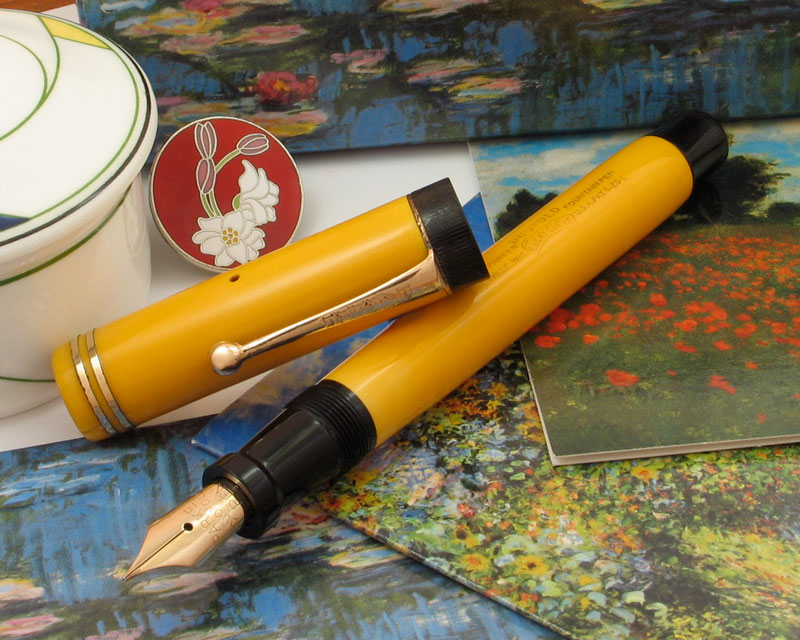
Parker Duofold Mandarin Yellow fountain pen, c1928-1929, open
The Parker Duofold Mandarin Yellow is one of the Holy Grail pens for many collectors. Pick up any general pen collecting book and you are likely to see a picture of a Mandarin somewhere, especially when the Parker Duofold is mentioned. Many stories have surfaced about the how the Mandarin Yellow came to be and why the pens are popular, some embellished, some true. The excellent book on the Parker Duofold, Parker Duofold, by David Shepherd and Dan Zazove, sets right many of the questions about the pen.
Mandarin Yellow was the fifth color introduced on the Duofold after Chinese Lacquer Red, Black, Jade Green, and Lapis Lazuli, making its debut in 1927. As with several other pen design choices, George Parker got the inspiration for the yellow color from a trip he took. George Parker was interested in the designs of other cultures and would incorporate these ideas into pens designs. His inspiration for the Awanyu Aztec pen was from seeing early American Indian designs in Santa Fe, New Mexico, when he visited the museum of the Archeological Institute of America. The Mandarin Yellow color was inspired by a Cloisonné vase he purchased in Japan. All things oriental were the rage in the late 1920s, and George Parker noted that yellow was in as a high fashion color, so he decided to make a yellow Duofold, based on the yellow in the Cloisonné vase. His initial name for the color was Imperial Yellow, introduced in April, 1927, on a single wide cap band Duofold made of Permanite plastic.
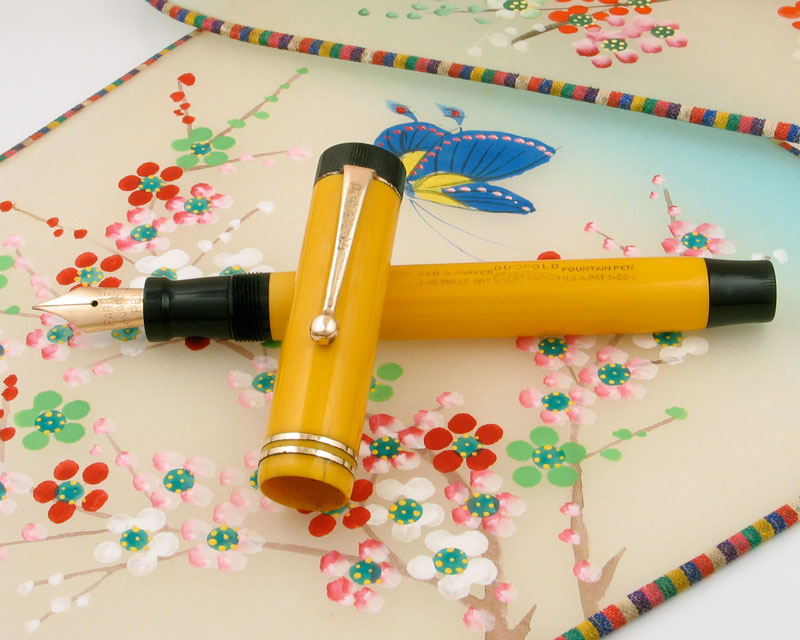
Parker Duofold Mandarin Yellow fountain pen, c1928-1929, open
The 1927 Parker Catalog shows the new color as "Chinese Yellow," and it appears on a single wide cap band Senior ($7.00 retail), single wide cap band Junior ($5.00 retail) and Lady wide cap band (to the cap lip) ringtop pen ($5.00 retail), each offered with matching pencils ($4.00, $3.50, and $3.00 retail, respectively). The ringtop pen could also be had with a clip. These earliest pens had the barrel threads cut into the yellow barrel where it meets the section, with the section in black. Because of complaints that the yellow threads attracted ink stains too easily, Parker redesigned the section so that the threads now appeared on the black section itself, as shown on this pen.
In 1928 Parker changed the cap design to two narrow cap bands on the Senior and Junior models and three narrow cap bands on the Lady model. There was no change in pricing. The 1929 Parker Catalog calls the color "Imperial Mandarin Yellow," though Parker advertisements use the shorter Mandarin Yellow name, which is the name that most collectors use today. This was also the last year for "flat top" design Duofolds such as this example pen, as Parker streamlined all Duofolds after the introduction of the Sheaffer Balance in 1929.
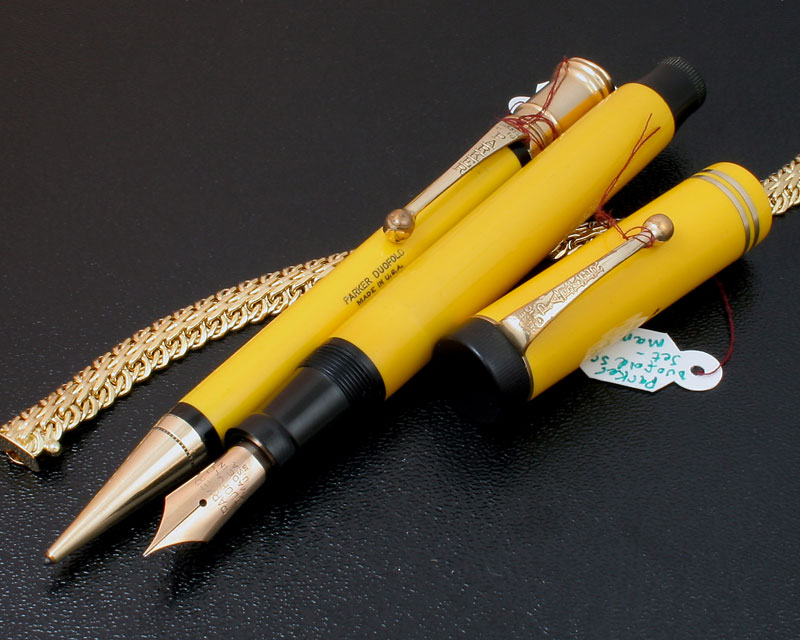
Parker Duofold Mandarin Yellow fountain pen, and pencil set, c1928-1929, in fine condition with some brassing on the clips
One of the main reasons Parker introduced the new Mandarin Yellow (and Lapis Lazuli blue) in 1927 was to counter the popularity of the Sheaffer Jade Lifetime flat top pens that were eating into Parker Duofold sales. Yellow was indeed a striking color on a pen in 1927 and initial sales of the new pen were good, with Parker making repeated production runs to keep up with demand. Gradually, the newness faded, and the Mandarin Yellow pens became the slowest sellers in the line.
Parker offered the Duofold Mandarin Yellow, as with other Duofolds, with six firm nib types, extra fine, fine, medium, broad, stub, and oblique. These large nibs were essentially Parker number 6 nibs with the Duofold stamping. Duofold nibs write wonderfully smoothly, but are as firm as a ten penny nail.
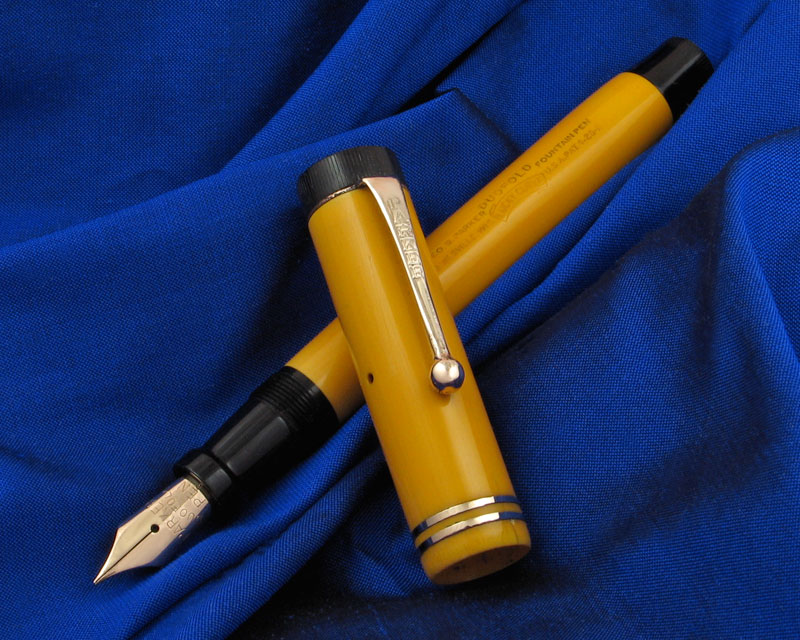
Parker Duofold Mandarin Yellow fountain pen, c1928-1929, open
This Parker Duofold Mandarin Yellow Senior is a large, yet lighter weight pen, weighing 0.8 ounce and being 5 3/8 inches long with the cap on and a huge 6 3/4 inches with the cap posted on the end of the barrel. Parker Duofolds post perfectly, but the Permanite plastic hardly lives up to its name, as Mandarin Yellow pens are highly prone to cracking, especially at the cap lip, as can be seen in the photographs of this pen. I never post this pen and don't recommend ever posting a Mandarin Yellow Duofold. Why risk destroying a very expensive and fragile pen?
The Parker Duofold button filling system is very easy to use. There is a button at the base of the barrel (under the blind cap), which is pressed, bending a pressure bar inside the barrel, which squeezes the ink sac. The pen is held with one hand with the nib in the ink and the button is pressed with the thumb. Be careful not to lose the blind cap! Wipe the nib and section and you are ready to write. Although a large size pen, Parker Duofolds don't hold a lot more ink than smaller size pens. This Parker Mandarin Yellow cam with a wonderfully smooth writing fine nib. I enjoy writing with it, but I do worry about its durability.
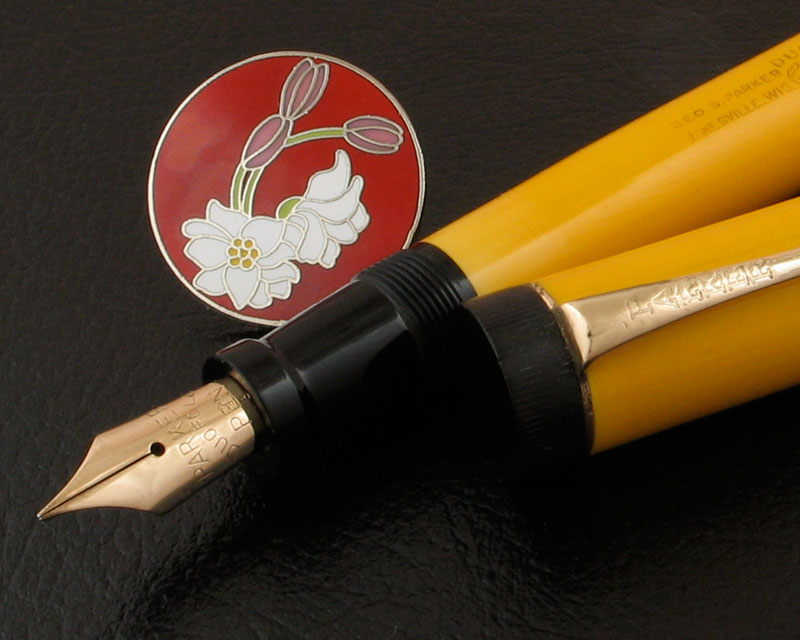
Parker Duofold Mandarin Yellow fountain pen, c1928-1929, cap and nib detail
Parker Duofold Mandarin Yellow "flat top" Seniors are the most desirable and collectible of the Mandarin Yellow pens. Among Senior size pens, the most valuable would be the earliest pens with the yellow barrel threads, and the least valuable would be the streamlined pens made from 1929 forward. The Mandarin Yellow plastic is very fragile, so take care if you plan to use one of these pens. There are some cases where the plastic has shown some fading, though discoloration problems are not as acute as with the Jade Green or Lapis Lazuli color pens. As with most Duofolds, clip and cap band plating loss is also a problem.
One thing to beware of is replacement caps. Because the cap lips are so prone to cracking and even chipping off pieces, some collectors have resorted to having the entire cap replaced with a newly made piece. This is no longer an authentic pen and should be represented as such. If the cap looks too perfect, especially if it shows some variation with the barrel or a complete lack of any tiny hairlines at the cap lip, ask questions about its history before you shell out big bucks for one of these pens.
Although not rare, the Mandarin Yellow pens are generally the priciest of the Duofolds, even with user grade pens. You may be able to find the Holy Grail of Duofolds, but the question will be, can you afford it! You can read more about the Parker Duofold flat-top pens in this article: Parker Duofold Flat-Top Pens 1921-1929.
Selected References
Fountain Pens of the World, Andreas Lambrou, Copyright © 1995, Zwemmer, London, England
Fountain Pens: United States and United Kingdom, Andreas Lambrou, Copyright © 2000, Phillip Wilson Publishers Ltd, London, England
Parker Catalog, 1927, Parker Pen Company, Janesville, WI, USA
Parker Catalog, 1929, Parker Pen Company, Janesville, WI, USA
Parker Duofold, David Shepherd and Dan Zazove, © Copyright 2006, Surrenden Pens Limited, Brighton, UK
Discuss / Recommend what you read on PenHero.com
Follow us on Twitter: PenHero
Add a link to PenHero.com on your blog:
(Copy & paste code)
Please only use the photo provided. Use of other photos requires permission.
The provided link photo will change as we update the site.
Comments on this article may be sent
to the author, Jim Mamoulides
PenHero.com Bibliography
